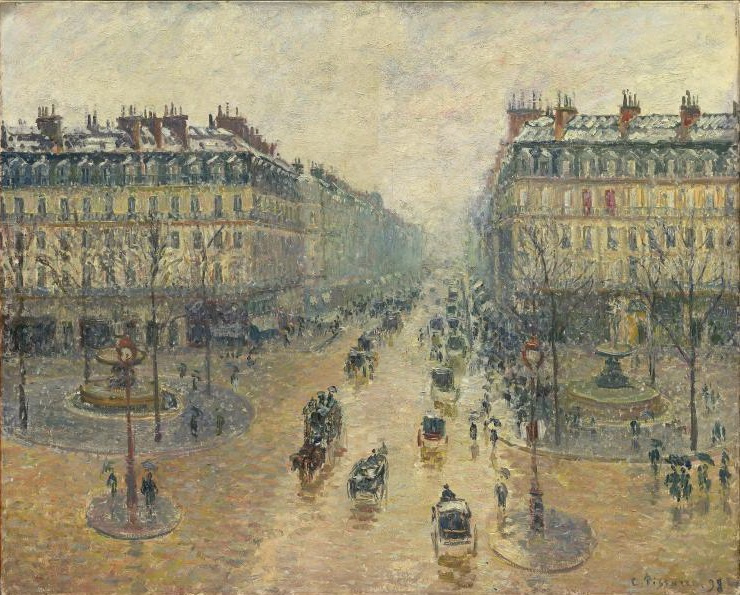The Avenue De L'Opera, Paris, Sunlight, Winter Morning
Description of the artwork «The Avenue De L'Opera, Paris, Sunlight, Winter Morning»
n the 1890-s, the 60-year-old Camille Pissarro, at last, earned a recognition. The art dealer Paul Durand-Ruel organized the exhibition dedicated to the artist’s urban series. And all his boulevards, painted in the rain, snow and sunny weather, immediately found buyers and got to private collections.
The elderly Pissarro painted Paris. This was unexpected. The artist had always lived in the village, mainly because it was much cheaper to rent a house there. And because it was possible there, having a garden and an orchard, to feed a family of 9 people, even if the paintings weren’t sold. And he often painted the rural landscapes: ploughed land, fruit trees in blossom, winding dirt roads, crisp frosts and spring floods.
In 1884 he settled in the village of Eragny and was soon able to buy the house thank to Claude Monet’s financial help. Here Pissarro would live his last 20 years of life, leading a real peasant life. But with age, the artist developed eye disease and it prevented him from working in the sun. Then he decided to paint, looking out the window. Having never left Eragny for long, Pissarro started living in Paris every now and then.
In 1897, settling in the heart of the capital, at the "Hotel du Louvre", Pissarro wrote to his son that he was delighted that he could try to paint “these Paris streets, which are often called ugly, but which are so silvery, so luminous and so lively ... ”
But why are they ugly? What was wrong with those streets? Like any radical, ruthless modernization of the city, the rebuilding of Paris, led by Baron Haussmann, caused a fierce opposition from the citizens, some of which were in complete despair. Degas, for example, considered Haussmann the most destructive phenomenon that befell Paris in its entire history, worse than wars and natural disasters. The old town just disappeared: 200 thousand buildings were destroyed, 34 thousand – rebuilt beyond recognition. Once narrow and winding cobbled streets turned into wide boulevards, reaching 18 meters in width. And those vast squares that could cause an attack of agoraphobia! Those five-floor buildings, a new opera house, a hippodrome, the mighty metal props of railway bridges! Young artists managed to love this modern bustling Paris easily and Pissarro decided to discover this love for himself at the age of 67.
Pissarro returned to this hotel several times and looking out it’s window, created 11 paintings, overlooking La Place due Théâtre and the Avenue De L'Opera. He painted sunny, cloudy, snowy, foggy and rainy days, the middle of the day and the early morning. Pissarro had always been like that: a dad, a good God, a Moses, as he was called by his fellow Impressionists, he had a tremendous impact on everyone who was nearby. He was not much older than others, but with his unwavering calmness of an ancient prophet, he soothed their emotional storms and doubts. And until the rest of his life the artist was ready to learn anew how to live and paint every day, without losing his significance even for a moment.
Pissarro loved those ugly, lined, wide and noisy streets of Paris as if he saw them for the first time.
Author: Anna Sidelnikova


